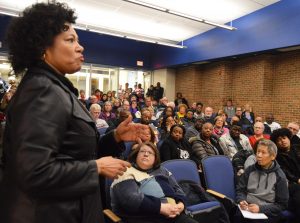Peoria panel addresses racism, talking local and national solutions
By Elise Zwicky For Chronicle Media — March 14, 2019
Peoria native Rose Clark Morris traveled from her current home in Flint, Mich., to attend a recent forum on the legacy of racism and its impact in Peoria at Illinois Central College’s North Campus. (Photo by Elise Zwicky / for Chronicle Media)
A diverse crowd of more than 100 people turned out for a recent public forum on the ongoing legacy of racism and its impact on Peoria at the Illinois Central College Peoria campus.
“If we ever are going to eradicate racism, we have to face it head-on: talk about it, discuss it and move forward,” the Rev. Marvin Hightower, president of the Peoria NAACP and moderator for the forum, told the standing-room-only crowd in the Arbor Hall auditorium.
Panelists Pam Adams and Sherry Cannon discussed a trip they made to Montgomery, Ala., to visit the National Memorial for Peace and Justice and the Legacy Museum: From Enslavement to Mass Incarceration. The two museums that were opened last year by the Equal Justice Initiative.
“Montgomery is a contradiction. It’s the bed of (the) Confederacy, but it’s also the birth place of the Civil Rights movement,” said Cannon, a columnist and founder of the Hope Renewed Youth Conference who also serves with the NAACP and the SouthSide Mission.
In talking with Uber drivers, motel clerks and others in the city, Cannon said it was interesting to learn that many Montgomery residents had yet to step inside the new museums.
“There’s still that division there. We’ve come a long way, but there’s still a lot of work to be done,” she said.
Both Cannon and Pam Adams, a retired newspaper reporter, experienced emotional reactions at the National Memorial, which is also called the Lynching Museum.
“I actually found a person that was lynched that I believe was a family member of mine,” said Cannon. “I haven’t been able to confirm he’s a relative, but he was accused of stealing from chicken coops and was lynched in Pike County, Mo., in 1915.”
Some of the lynchings documented at the museum took place in Waco, Texas, and Hinds County, Miss., where Adams’ family was from.
“I realized my grandparents definitely would have known about these. My father would have known about these. But I never heard them talk about it,” Adams said.
The museum features many rows of hanging columns engraved with the counties, states and names of people who were lynched there. More than 800 columns memorialize more than 4,000 lynchings that were documented from 1877 to 1950.
“We always think of lynching victims as men, but you see many women and children, too,” Adams said. “In many cases, the names are simply unknown, and that kind of breaks you.”
Five columns with nearly 60 names represent Illinois, which had the third highest number of lynchings in states outside the south, Adams said. “We had them as close as Marshall County, Fulton County and Sangamon County,” she added.
Each of the columns has a twin in a grassy knoll on the memorial grounds that can be claimed by the communities where the lynchings occurred to begin the process of reconciliation.
Through its words, images and interactive exhibits, the museum shows that modern-day policing and mass incarceration are direct descendants of slavery, segregation and white supremacy, Adams said.
“It’s designed to make us rethink what we think we know about slavery, about lynching, about racism, about mass incarceration, about the death penalty,” she added.
Panelist Anthony White, a retired police officer who teaches criminal justice at ICC, said, “When we start speaking to mass incarceration and disparity in sentencing, people being in jail for non-violent charges because they’re poor…All of that has a nexus to slavery.”
Addressing a written question from the audience asking if police shootings of unarmed African-Americans are an evolved form of lynching, White said, “When it’s clearly a bad shooting–and technology today is really making it a lot more evident when it’s bad–then yes, that’s a form of what you could call racial terror lynching because it sends a message to everyone in that community that if you do this, you could be susceptible to that.
“But you have to approach this by really looking at each individual case,” he added. “Officers are human, and they can make a mistake.”
White also noted that the two core areas in a democratic form of policing are accountability and transparency. “For officers who do those bad racially motivated shootings, if the judicial system could go ahead and mete out convictions, maybe that would also slow down this tide,” he said.
Another question asked what role white people can play in moving toward racial equity.
Hightower responded, “Talk to other white people about how wrong it is. Then we can come together and dialogue together, because you’d discover we have more in common than we do differences. We all really are just one race, which is human.”
Cannon added, “We can’t change hearts but we can change laws. To me it’s policy. We have to have laws changed in order to have equity and equality. When you have laws that are slanted for or against a people, then those are unfair laws that we need to address and look at.”
Hightower concluded, “We won’t solve it overnight because we didn’t get here overnight. But if we put the work into it, we can make some gains in Peoria. We don’t have to stay the worst city for African-Americans. We don’t have to stay the most segregated city for education. We can choose to stay, but I choose to try to move the needle forward.”
The forum was sponsored by the Peoria NAACP and the Journalism Diversity Fund created with assistance from the Community Word. For more information about the National Memorial for Peace and Justice and the Legacy Museum, visit the website www.museumandmemorial.eji.org/memorial or the Equal Justice Initiative website at www.eji.org.







